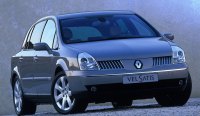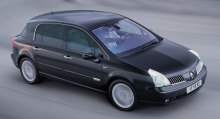|
 French
big cars gave us these impressions: cosseting ride, tasteful interior,
comfortable seats. These qualities characterized the late Citroen CX,
XM,
Renault 25 and Safrane. Unfortunately, in the past 10 or so years they
were progressively outclassed by German prestige sedans, to the extent
that most people now regard them as the alternatives if one cannot
afford
German products. However, while the German brands are enjoying huge
success,
their 5-series, A6 and E-class are getting more and more similar to
each
other, so close that car journalists can use to the same phrases to
describe
them without thinking. French
big cars gave us these impressions: cosseting ride, tasteful interior,
comfortable seats. These qualities characterized the late Citroen CX,
XM,
Renault 25 and Safrane. Unfortunately, in the past 10 or so years they
were progressively outclassed by German prestige sedans, to the extent
that most people now regard them as the alternatives if one cannot
afford
German products. However, while the German brands are enjoying huge
success,
their 5-series, A6 and E-class are getting more and more similar to
each
other, so close that car journalists can use to the same phrases to
describe
them without thinking.
With
the new Renault Vel Satis, it’s time to have something special again.
First
of all, let me remind you that the Vel Satis is no cheap alternative to
its German rivals. In fact, in the top-spec Initiale trim it costs more
than a BMW 530i. Although it does pack more extra equipment, it does
not
have a brand name as prestige. Lexus and Infiniti, for example, would
rather
lower their price by 10% to avoid direct competition with the German.
In
contrast, Renault is much braver with the Vel Satis. It believes
instead
of lowering price it would be better to offer something different to
the
German in order to attract the rest of the buyers and those opt for
luxurious
MPVs in the past. This result in the world’s first MPV-like luxurious
executive
sedan.
 The
first thing notice when you see the Vel Satis for the first time is its
height - some 142mm taller than a 5-Series. Not only the roof is taller
but the waistline and bumper level are also higher. The second thing is
that it looks like a hatch, just enlarged in every dimensions. Yes, it
IS a hatchback. French does not care about the stupid rule saying
luxurious
sedan must be 3-box. Renault 25 and Safrane already proved that
hatchback
can be just as fine to look, while with better practicality. Talking
about
the hatchback, you may notice that its wrap-around rear window
resembles
the lovely Renault 25, but what you might not notice is that the
tailgate
is now made of composite in order to reduce weight, or compensate the
extra
weight of the big glass window. The
first thing notice when you see the Vel Satis for the first time is its
height - some 142mm taller than a 5-Series. Not only the roof is taller
but the waistline and bumper level are also higher. The second thing is
that it looks like a hatch, just enlarged in every dimensions. Yes, it
IS a hatchback. French does not care about the stupid rule saying
luxurious
sedan must be 3-box. Renault 25 and Safrane already proved that
hatchback
can be just as fine to look, while with better practicality. Talking
about
the hatchback, you may notice that its wrap-around rear window
resembles
the lovely Renault 25, but what you might not notice is that the
tailgate
is now made of composite in order to reduce weight, or compensate the
extra
weight of the big glass window.
Styling
is obviously a strong card of Vel Satis, at least Renault design boss
Patrick
Le Quement thinks so. He said the car follows the theme set by the 1998
concept car bearing the same name, but what I find is a beauty against
a beast. Calling the production car a beast might be too hard, but the
angry face with louvred grille and diamond-like headlights is not
easily
acceptable at first sight. It grows on you with time however. It has
many
elegant details, such as the bumpers with recessed square patterns and
topped by a fine chromed line. Most important, the Vel Satis looks
distinctive
compare with any other executive sedans on the road.
  |
Vel
Satis Concept (1998)
Said to be the
inspiration for the
production car. It's far more handsome though. |
Open
the door and you will find a seat locating much higher than usual. You
sit on the seat easily rather than drop onto it. You get off even
easier.
The MPV profile also benefits headroom, making the car extremely
spacious.
Rear legroom is also vast, but that is more out of the 2840mm wheelbase
rather than the MPV profile. Passengers enjoy considerably more space
here
than in a E-class or 5-Series. Boot space is also very generous, thanks
to a compact suspension design (we’ll discuss that later) and the fact
that the Vel Satis is a front-wheel-drive machine. Rear bench is 60/40
split, although it does not fold flat.
This
is a really tasteful cabin. Big windows give it light and airy ambience
unfound in German cars. Light wood trim (with recessed square patterns
like the bumpers), high quality plastic and cream leather result in a
luxurious
yet warm environment. The design of dashboard and console is perhaps
the
biggest success among all Le Quement cars. In other words, they are
tastefully
styled. Fit and finish is also up to German standard, which is quite
surprising.
Better still is the front chairs with double hinges at backrest to
enable
a perfectly comfortable support that will please elderly having back
problems.
Rear passengers enjoy a LCD screen displaying DVD movies. In short, the
Vel Satis has the most comfortable yet beautiful cabin in executive
class.
While
Mercedes sells 300,000 E-class in just a little more than 1 year,
Renault
plans to sell the same number of Vel Satis in its 6-year life span.
Obviously,
it cannot afford a unique platform thus cost sharing is inevitable.
Therefore
the Vel Satis shares platform with Laguna and the forthcoming new
Espace,
and to lesser extent, the Avantime. This allow the car to be produced
in
the same plant of Laguna and Espace, sharing 80% tooling. However, the
Vel Satis has its own rear suspensions instead of Laguna’s simple
torsion-beam
axle. Renault calls that a "Trigonal linkage", a patented design. The
advantage
is compact size while providing good compromise in ride and handling,
although
it is unlikely to trouble rivals' more sophisticated multi-link. The
hub
carrier and upper link are made of aluminium to reduce unsprung mass,
hence
better ride comfort. Front suspension remains to be MacPherson struts.
Both rear and rear suspensions are mounted on subframes to reduce noise
and harshness.
 The
Vel Satis is a big car. Measuring 85mm longer, 60mm wider and 142mm
taller
than a 5-Series, it tips the scale at up to 1735kg. This has already
taken
the aluminium engine and aluminium doors into account. What will happen
when you throw such a big piece of metal into bends ? especially with
high
center of gravity ? will it handle like a van ? The
Vel Satis is a big car. Measuring 85mm longer, 60mm wider and 142mm
taller
than a 5-Series, it tips the scale at up to 1735kg. This has already
taken
the aluminium engine and aluminium doors into account. What will happen
when you throw such a big piece of metal into bends ? especially with
high
center of gravity ? will it handle like a van ?
Surprisingly,
Vel Satis is pretty competent in handling department, although it does
not inspire the driver. The suspension setting is stiffer than usual
standard
of French cars. On most roads it damps beautiful enough, but on really
bumpy roads it will be unsettling. This may be disappointing for a
French
car, but in return it resists body roll well. It does not understeer
very
much. It has plenty of grip and adequate steering precision.
What
it lacks is a sharper edge that lifts BMW 5-Series above everyone else.
The Vel Satis handles safely and solidly. It is easy to drive. It is
also
nimbler than its size and weight suggest. However, its steering needs
more
feel, although already better than Safrane. Drivers are unlikely to
push
it into corners in the way like 5-series. If so, it will understeer
like
any front-drive cars.
What
about on straight line ? with 1720kg to pull, Renault seeks help from
Nissan’s
big capacity V6 to power the flagship Vel Satis. This VQ35DE, an
all-alloy
3.5-litre V6 with continuous VVT at both intake and exhaust cams and a
resonance variable intake, came from Altima and Maxima. With 245hp and
85% of its 243 lbft maximum torque from 1200rpm, it is the best thing
Renault
can dream of. The VQ is also renowned for its smoothness and
enthusiastic
sound. Renault claims this Vel Satis accelerates from 0-60mph in 7.8
seconds
and tops 146mph. Good enough considering the comfort bias of the car.
The
top diesel engine also comes from Japanese - this time by Isuzu. This
is
a 3.0-litre V6 with an odd 66° angle, 24 valves, an unusual
aluminium
block, common-rail injection and variable nozzle turbo. It pumps out
180hp
and 258 lbft from 1800rpm. Yes, it is the same engine serving Saab 9-5
3.0 TiD.
Both
V6s employ an intelligent Proactive 5-speed automatic with Tiptronic
function.
It shifts smoothly and reacts keenly to driver input. Other engines
include
a new light-pressure turbo 2.0 four-cylinder (165hp) and a 2.2dCi
common-rail
turbo diesel (150hp). They works with the superb 6-speed manual gearbox
from Avantime. However, the budget choices fail to deliver satisfactory
performance.
Conclusion
There
are some exec sedans look prettier. Some ride better. Some go quicker.
Many handle sharper. Nevertheless, the Vel Satis has a place of its
own.
In the homogeneous world of luxurious automobiles, it brings us fresh
air
and a really interesting idea of what a luxurious car could be. Yes,
revolution
started from France.
|